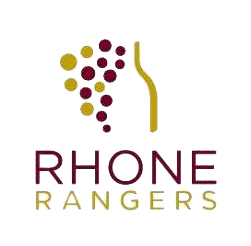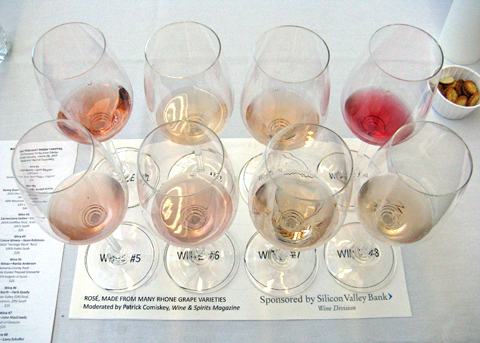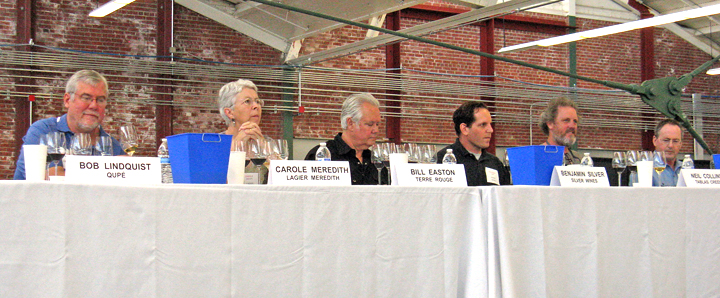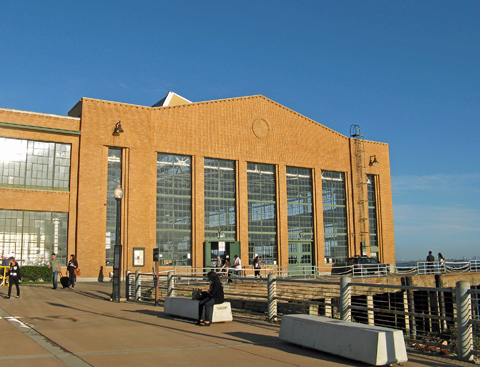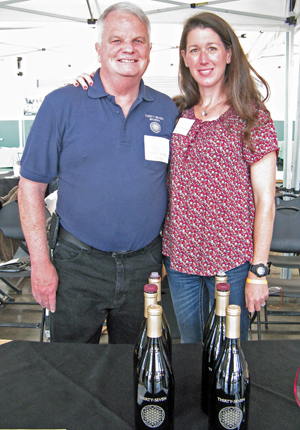Acquiesce Vineyards
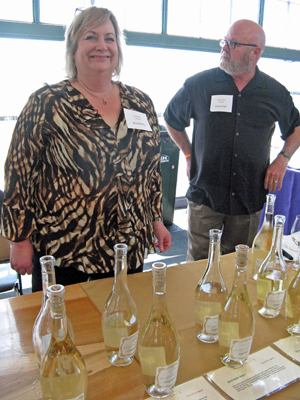 |
Acquiesce 2014 Picpoul Blanc, Estate, Lodi. Very light straw color, with tart stone fruit and citrus aromas with a slight herbal note. Lighter weight on the palate with vibrant acidity and a clean finish.
Acquiesce 2014 Grenache Blanc, Estate, Lodi. Light straw color, this displayed more upfront pear and stone fruit aromas with touches of fresh herbs and flowers. Medium-light bodied with a bright texture and crisp finish, nice.
Acquiesce 2014 “Belle Blanc,” Estate, Lodi. 45% Grenache Blanc, 45% Roussanne, 10% Viognier. Light straw color, showing tropical fruit on the nose along with earth and herb notes. Medium-bodied with a somewhat richer mouthfeel and smooth, pleasant finish, nice.
Acquiesce 2014 Roussanne, Estate, Lodi. Light straw color, with earth and lees notes along with pear and stone fruit and a touch of spice. Medium-rich on the palate but with good acidity and a clean finish.
Acquiesce 2013 Viognier, Estate, Lodi. Light straw color, featuring stone fruit, spice, and earth aromas plus a hint of lemonpeel. Medium-bodied with a smooth but lively finish.
Acquiesce 2014 Grenache Rosé, Estate, Lodi. 80% whole-cluster press plus 20% left on the skins before pressing. Very light salmon/pink color, this showed upfront fresh strawberry, herbs, and spice on the nose. Medium-light weight in the mouth with a clean finish.
Comments: Acquiesce was established in 2012, and owner/winemaker Sue Tipton and her husband Rodney were on hand at the tasting. All the wines are from estate-grown fruit (Tablas clones) and are made entirely in stainless steel. A Lodi winery specializing in crisp Rhône-variety whites is a rarity, and it’s a bonus when the wines are a tasty as these – all of them good, with the Grenache Blanc and “Belle Blanc” blend being my favorites this year.
Anglim Winery
Anglim 2014 Rosé, Paso Robles. Mostly whole-cluster pressed Grenache and Syrah, plus a little Mourvèdre saignée and 2% Viognier. Light salmon color, this featured bright strawberry aromas along with floral and herbal components and a hint of orangepeel. Medium-light bodied with a lively mouthfeel and a stony mineral note on the long finish, nice. (Tasted at the morning Rosé seminar)
Comments: Steve and Steffanie Anglim launched their winery in 2002. Their tasting room is located in the restored train station building just a couple of blocks from the downtown city park in Paso Robles. Specializing in Rhône-variety wines, they also produce Pinot Noir. Steve mentioned at the morning Rosé seminar that he finds the Grenache component provides most of the fruit for this wine, while he gets structure from the Syrah, and color and tannin from the Mourvèdre.
Bonny Doon Vineyard
Bonny Doon 2012 “Vin Gris de Cigare Réserve (en bonbonne),” California. From 69% Mourvèdre, 20% Grenache, and 11% Cinsaut, made in 5-gallon glass demijohns (bonbonnes). Very light salmon/straw color, this had some sulfur aromas at first, with spicy, savory, and earthy notes upfront and very subtle stone fruit in the background. Medium-bodied with a fairly smooth texture, very distinctive. (Tasted at the morning Rosé seminar)
Bonny Doon 2011 “Le Cigare Volant Normale,” Central Coast. 37% Mourvèdre, 34% Grenache, 20% Syrah, 9% Cinsault. Medium purple color, with loads of spice on the nose along with plummy fruit, earth, and a touch of black pepper. Medium weight on the palate, finishing with moderate tannins.
Comments: One of California’s early “Rhone Rangers,” Randall Grahm of Bonny Doon Vineyard originally was aiming to make great Pinot Noir but ultimately moved toward varieties from the Rhône Valley and elsewhere. “Le Cigare Volant” has become known as Bonny Doon’s flagship wine – its first vintage was in 1984. Many of Bonny Doon’s vineyards are now farmed using biodynamic methods.
Burt Street Cellars
Burt Street 2013 Rosé, Sonoma Coast. From 57% Grenache, 43% Syrah, saignée after about 24 hour skin contact. Light pink color, showing upfront strawberry, spice, and earth aromas. Medium-light weight with a lively texture and finish.
Burt Street 2013 Syrah, Herman Vineyard, Sonoma Valley. From 20+ year old Durell clone vines, aged in 30% new French oak. Medium dark purple, with ripe dark berry fruit, lots of spice, and undertones of sweet oak. Medium-bodied with good structure and moderate tannins.
Burt Street 2013 Grenache, Judge Vineyard, Bennett Valley. Aged in about 30% new French oak. Medium-light garnet/ruby, this displayed bright black cherry, spice, and dried herbs on the nose. Medium weight on the palate with juicy acidity, finishing with firm tannins – this could use more time in the bottle but has very good potential.
Burt Street 2013 Syrah, Judge Vineyard, Bennett Valley (barrel sample). To be bottled a few days after the tasting, aged in 40% new French oak. Dark purple color, with aromas of blackberry, flowers, spice, and vanilla/oak. Big and rich, with plenty of structure and a grippy tannic finish – has promise but needs time to settle down.
Burt Street 2011 Grenache, Sonoma Coast. 75% Grenache, 25% Syrah, sourced from Old Lakeville Road Vineyard in the Petaluma Gap. Medium color, featuring higher-toned red fruit and spice, plus hints of earth and pepper. Medium-bodied, this finished with big, chewy tannins.
Comments: In 2009, three friends – Joshua Haberman, Jonathan Tyer, and Timothy Skok – started the winery in a garage on Burt Street in Santa Rosa. The first commercial vintage was from 2011, and the winery produces Chardonnay, Pinot Noir, and Cabernet in addition to their Rhône-style wines. They source fruit from cooler-climate vineyards in Sonoma Valley, Bennett Valley, and Anderson Valley. This was a promising debut for Burt Street at the Rhone Rangers tasting.
Clos Saron
Clos Saron 2013 “Out of the Blue,” California. 90% old-vine Cinsault, 5% Syrah, 5% Graciano, co-fermented. Medium-dark purple, this had earthy aromas along with bright black cherry fruit and spice. Medium-bodied with a very lively texture and refined tannins on the finish.
Clos Saron 2011 Syrah, “Stone Soup,” Sierra Foothills. 100% Syrah. Dark purple, more fruit-forward with plum, spice, dried herbs, and smoked meat on the nose. Medium weight on the palate with moderate, chalky tannins, nice.
Clos Saron 2009 “Cuvée Mystérieuse,” Sierra Foothills. 64% Syrah, 30% Merlot, 6% Viognier, co-fermented. Medium-dark color, showing earth, leather, spice, and dark berry fruit. Big and structured, with a chewy tannic finish.
Clos Saron 2009 “Heart of Stone,” Sierra Foothills. 90% Syrah, 10% Viognier, co-fermented. Dark purple, with earthy, funky aromas along with herbs, plummy fruit, and a slightly floral note. Medium-full bodied with chewy tannins – not sure where this will go but it’s quite intriguing.
Comments: Clos Saron owner/winemaker Gideon Beinstock poured his wines at the event. Always a little different, these wines can be hit-and-miss but the best of them are very distinctive and tasty. The Cinsault for the “Out of the Blue” bottling comes from 120+ year old vines from Lodi’s Bechthold Vineyard. The “Stone Soup” Syrah was showing particularly well at this tasting.
Cornerstone Cellars
Cornerstone 2013 Rosé, “Corallina,” Napa Valley. From 100% Syrah from the Oak Knoll District, farmed specifically for Rosé, whole-cluster pressed and aged in neutral oak. Very light salmon color, displaying stone fruit and tropical fruit aromas, earth, and a leesy note. Medium-light weight, this had moderate acidity and fairly smooth finish. (Tasted at the morning Rosé seminar)
Comments: Mike Dragutsky founded Cornerstone in 1991, and in 2008 he was joined by Craig Camp and Jeff Keene. Best-known for their fine Napa Valley Cabernets, Cornerstone has also made Willamette Valley Chardonnay and Pinot Noir in recent years. The Rosé is from the winery’s Artist Series Stepping Stone line that offers more value-priced bottlings.
Domaine de la Terre Rouge
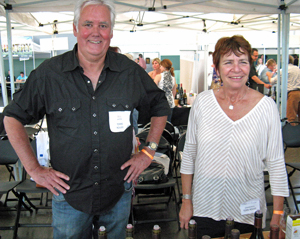 |
Terre Rouge 2011 Roussanne, Monarch Mine Vineyard, Sierra Foothills. Light straw color, with spice, stone fruit, earth, and a stony mineral note. Moderately rich mouthfeel with good acidity and a long, smooth finish – nice now and should age well.
Terre Rouge 2010 “L’Autre,” Sierra Foothills. 73% Grenache, 14% Syrah, 13% Mourvèdre. Medium color, this featured red fruit, pepper, and herbs on the nose. Medium-bodied with a lively mouthfeel and moderate tannins, nice.
Terre Rouge 2009 Syrah, DTR Ranch, Fiddletown. Sourced mostly from older, self-rooted vines. Dark purple color, with aromas of plum, earth, smoke, and dried herbs. Big and structured, this finished with fairly grippy tannins.
Terre Rouge 2008 Syrah, Sentinel Oak Vineyard, Pyramid Block, Shenandoah Valley. Aged in 33% new French oak. Dark purple, displaying riper plummy fruit, earth, leather, spice, and a background of vanilla/oak. Fairly full-bodied with plenty of structure and chewy tannins on the finish. (Tasted at the morning “See How They Age” seminar)
Terre Rouge 1998 Syrah, Sentinel Oak Vineyard, Pyramid Block, Shenandoah Valley. Medium-dark brick/purple color, this had more earth and leather notes along with plum, herbs, and a touch of grilled meat on the nose. Still big and structured with a grippy tannic finish – starting to soften just a little. (Tasted at the morning “See How They Age” seminar)
Comments: A longtime leader among Sierra Foothills Rhône-style producers, Bill Easton of Terre Rouge poured his wines at the tasting. He founded his winery in Amador County’s Shenandoah Valley in 1994 – prior to that, he owned and ran the well-known Solano Cellars wine shop in Berkeley. Terre Rouge focuses entirely on wines made from Rhône grape varieties, while wines from Bill’s Easton label are made from non-Rhône varieties. Planted in 1999, the estate DTR Ranch includes about 7 acres of Syrah – mostly own-rooted Syrah 1, 877, and Noir clones – and ½ acre of Viognier. I thought the Roussanne and the Grenache-based “L’Autre” blends were standouts, while the two younger Syrah bottlings still could use more time in the cellar.
Field Stone Winery
Field Stone 2014 Rosé of Petite Sirah, “Heritage Block,” Estate, Alexander Valley. From 100% Petite Sirah, 80% tank-fermented and 20% barrel-fermented. Light ruby color, this showed upfront raspberry aromas plus notes of fresh herbs. Medium-light bodied with a smoother texture and a slight tannic bite on the finish. (Tasted at the morning Rosé seminar)
Comments: Field Stone was established in 1977 and is run by John and Katrina Staten and their family. Known mainly for their Cabernet Sauvignon, Merlot, Sauvignon Blanc, and Petite Sirah, they also make Viognier and Syrah as well as several other varietals and blends. The Petite Sirah fruit for both their red and Rosé versions of the wine comes from vines planted in 1894.
Folin Cellars
Folin 2014 Viognier, Folin Vineyard, Rogue Valley, Oregon. Just bottled, pre-release. Light straw color, with floral aromas along with stone fruit and a touch of spice. Moderately rich mouthfeel with a smooth finish.
Folin 2012 Grenache, Folin Vineyard, Rogue Valley, Oregon. Medium-light color, displaying bright ripe strawberry, herbs, and spice on the nose. Medium-bodied with a lively texture and good structure, this finished with firm but fine tannins.
Folin 2012 Mourvèdre, Folin Vineyard, Rogue Valley, Oregon. Medium purple, this featured ripe plummy fruit, spice, earth, and sweet oak. Medium weight in the mouth, finishing with moderate tannins.
Folin 2011 “Misceo,” Folin Vineyard, Rogue Valley, Oregon. 50% Grenache, 35% Syrah, 15% Mourvèdre. Medium purple color, with a more savory profile of herbs, smoked meat, pepper, and earth along with plum and raspberry fruit and a hint of vanilla/oak. Medium-bodied with a lively mouthfeel and refined tannins, nice.
Comments: As usual, owner/winemaker Rob Folin was on hand to pour his wines. The 25-acre estate vineyard, about ten miles north of Medford, is planted to Viognier, Syrah, Tempranillo, Petite Sirah, Mourvèdre and Grenache, with most plantings dating to 2002. All of the Folin wines are made entirely from estate fruit, and they continue to be one of the few American producers using Vino-Lok glass closures for their bottles. I thought the “Misceo” GSM blend was a standout this year and the Grenache was not far behind.
Holly’s Hill Vineyards
Holly’s Hill 2013 “Patriarche Blanc,” El Dorado County. 34% Roussanne, 33% Grenache Blanc, 33% Picpoul. Light straw color, displaying stone fruit, spice, and a hint of oak on the nose. Medium-light bodied with a fairly smooth mouthfeel and finish.
Holly’s Hill 2013 Grenache Blanc, Estate, El Dorado County. Light straw color, this had more upfront tart apple fruit, herbs, and a slightly floral note. Medium weight on the palate with a crisp finish.
Holly’s Hill 2013 “Patriarche,” El Dorado County. 85% Mourvèdre, 13% Syrah, 1% Grenache, 1% Counoise. Medium-dark purple, with earthy and savory aromas of herbs, pepper, smoked meat, and plummy fruit. Medium-bodied with a lively texture and moderate tannins, nice.
Holly’s Hill 2010 Syrah, “Wylie-Fenaughty,” El Dorado County. Medium-dark purple color, this featured more upfront ripe plum and blueberry fruit, plus spice, smoke, and touch of sweet oak on the nose. Fairly big a and structured, with a firm tannic finish.
Comments: One of the Sierra Foothills most consistent producers of Rhône-style wines, Holly’s Hill gets much of its fruit from its two estate vineyards, first planted in 1998 at an elevation of about 2,600 feet. Tom & Holly Cooper own the winery and their daughter Carrie is the winemaker, while Carrie’s husband Josh Bendick shares in the winemaking duties as well as sales and marketing. There is more Mourvèdre in their 2013 Patriarche than in past vintages, and this wine was one of my favorites of the tasting, while the Grenache Blanc was notable as well.
Hope Family Wines
Treana 2013 White, Central Coast. 50% each Marsanne and Viognier, fermented in 20% stainless steel and 80% French oak (20% new). Light straw color, with ripe stone fruit and tropical fruit aromas along with hints of flowers and herbs, and a touch of sweet oak in the background. Medium-rich mouthfeel with lively acidity and a smooth finish.
Austin Hope 2012 Grenache, Hope Family Vineyard, Paso Robles. From Tablas Creek, 513, 814, and 363 clones, aged in 35% new French oak. Medium-light garnet/ruby color, featuring ripe strawberry and cherry fruit, lots of spice, and vanilla/oak. Medium-bodied and structured, with a firm tannic finish.
Comments: The Hope family started growing wine grapes on their property in Paso Robles in 1978, starting with Cabernet. The Treana label was founded in 1996 and has focused on producing a white Rhône blend and red Cabernet-based blend each year. Austin Hope launched his eponymous label in 2000, and that same year he replanted his family’s vineyard, mostly to Syrah, Grenache, and Mourvèdre, along with some Roussanne and Bordeaux varieties.
Jessie’s Grove Winery
Jessie’s Grove 2013 Cinsault, “SinSo,” Bechthold Vineyard, Lodi. From 120+ year old vines. Medium-light ruby color, this displayed ripe black cherry and plum fruit, earth, and vanilla/oak on the nose. Medium weight on the palate, finishing with moderate tannins.
Comments: Tasted at the Lodi Wines table. Known for their old-vine Zin, Jessie’s Grove’s roots go back to the 1860s, when Joseph and Anna Spenker settled in the Lodi area to farm wheat – Joseph planted his first grapevines in the 1880s, and he planted what is now known as Bechthold Vineyard in 1886. This was one of four wines made from Bechthold Vineyard Cinsault that I tried at this tasting.
Kale Wines
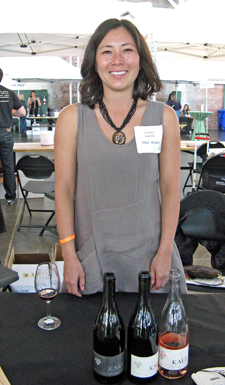 |
Kale 2014 Rosé, Sonoma County. From 85% whole-cluster pressed Grenache fermented in a concrete egg and 15% saignée Syrah fermented in barrel. Very light salmon/pink color, featuring subtle watermelon and strawberry fruit, herbs, and a floral hint. Medium-light bodied with lively acidity and a hint of stony minerals with just a slight touch of tannin on the finish, nice. (Tasted at the morning Rosé seminar)
Kale 2012 Syrah, “Broken Axle,” Stagecoach Vineyard, Sonoma County. 75% Syrah, 25% Grenache, all destemmed, fermented with native yeast. Fairly dark purple, this showed plum and darker fruits, earth, and spice on the nose along with undertones of sweet oak. Medium-rich mouthfeel, finishing with firm tannins.
Kale 2011 “Home Run Cuvée,” Kick Ranch Vineyard, Sonoma County. 70% Syrah, 30% Grenache, about 25% whole-cluster fermentation, aged in 25% new French oak. Medium-dark color, with herbal and floral components leading the way, plus black cherry and plum fruit, spice, and pepper. Medium-full bodied with good structure and big but refined tannins. This wine has really come together well over the past year or so – nice.
Comments: Kale Anderson started his label with his wife Ranko in 2008, focusing on Rhône-style wines. In the past, he’s worked for Mark Aubert at Colgin Cellars, and at Terra Valentine and Cliff Lede before joining Pahlmeyer in 2012 as director of winemaking for their Napa Valley wines. Red wines are mostly native fermentations in open-top stainless steel and French oak tanks. They get extended maceration and are aged about 18 months in 25%-33% new French oak. Ranko was behind the winery table this year, and the Kale Rosé and “Home Run Cuvée” were among my favorites of the event.
Lagier Meredith Vineyard
Chester’s Anvil 2012 “Gretna Green,” Napa Valley. 99% Roussanne, 1% Viognier. Very light straw color, this featured stone fruit, spice, and earth on the nose. Medium-bodied with a lively texture and crisp finish.
Lagier Meredith 2013 Rosé of Syrah, Mount Veeder. 79% Syrah, 16% Zinfandel, 7% Mondeuse, whole-cluster pressed with no malolactic fermentation, aged in neutral oak. Light salmon/pink color, this featured fresh red fruits along with touches of spice and fresh herbs. Medium-light weight on the palate with good acidity and a slight tannic bite on the finish.
Lagier Meredith 2011 Syrah, Mount Veeder, Napa Valley. Medium-dark purple, with upfront savory aromas of herbs and smoked meat, plus blackberry, pepper, and floral undertones. Medium-bodied, this finished with a stony mineral note on the firm tannic finish – very nice now but should age well for many years.
Lagier Meredith 2012 Syrah, Mount Veeder, Napa Valley. Aged for 20 months in older French oak. Medium-dark purple, with fresh blackberry, flowers, black pepper and a savory component. Medium weight with a lively texture and good structure, and a long finish with refined tannins, nice. (Tasted at the morning “See How They Age” seminar)
Lagier Meredith 2002 Syrah, Mount Veeder, Napa Valley. Medium-dark purple with a slightly reddish tinge, this showed a more gamey profile than the 2012 bottling, along with pepper, plum, and smoke aromas. Still structured on the palate but with a bit softer texture than the 2012, finishing with fine tannins – aging beautifully with plenty of life ahead of it. (Tasted at the morning “See How They Age” seminar)
Comments: As usual, Steve Lagier and Carole Meredith were behind their winery table at the tasting. The Chester’s Anvil label is a collaboration with Steve & Carole’s neighbors Aaron & Claire Pott of Pott Wine. The first Syrah plantings at the Lagier Meredith estate vineyard high on Mount Veeder came in 1994. As always, this was one of the tasting’s strongest line-up of wines – both the 2011 and 2012 Syrahs were outstanding, and the 2002 poured at the morning seminar was still youthful.
MacLaren Wine Company
MacLaren 2012 Syrah, “Bonnie Glen,” Bennett Valley. Pre-release. Sourced from Vivio Vineyard, from 470, 174, and 877 clones. Medium-dark purple, displaying blackberry, herbs, a floral note, plus spice and black pepper components. Medium weight with a lively texture and fine tannins, nice.
MacLaren 2012 Syrah, Samantha’s Vineyard, Russian River Valley. Pre-release. Medium-dark color, with more upfront plummy fruit along with spice and a touch of sweet oak in support. Medium-full bodied with good acidity and a grippier tannic finish.
MacLaren 2012 Syrah, Stagecoach Vineyard, Napa Valley. Pre-release. Medium-dark purple, this had riper plum and spice aromas with notes of earth and vanilla/oak. Richer mouthfeel with good structure and fairly big but refined tannins.
MacLaren 2013 Pinot Noir, “Heather,” Russian River Valley. Sourced from three vineyards, entirely destemmed and aged in neutral oak. Medium-light ruby color, showing bright cherry fruit, spice, and dried herb on the nose. Medium-bodied with a smooth but lively texture and fine tannins.
Comments: MacLaren was founded in 2007 by Steve and Heather Law, and focuses on cool-climate Syrah. The Syrahs use little or no whole-cluster in their fermentations and are aged in mostly older oak. Steve poured his wines at the event, and he noted that he looks to the Northern Rhône for his inspiration. The MacLaren wines I’ve tasted have been fine examples of cool-climate California Syrah. Since I’d tasted Steve’s current 2011 releases a few months earlier (the Atoosa’s Vineyard and “Drouthy Neebors” bottlings were my favorites), he poured me a preview of his upcoming 2012 Syrahs.
Onesta Wines
Onesta 2011 Cinsault, Bechthold Vineyard, Lodi. From 120+ year old vines. Medium-light garnet/ruby color, this featured upfront red fruit along with earth and lots of spice, with undertones of sweet oak. Medium-light bodied with moderate acidity and milder tannins.
Comments: Tasted at the Lodi Wines table. Onesta is the label of Jillian Johnson, who first worked with old-vine Cinsault from Bechthold Vineyard when she was associate winemaker at Bonny Doon. Onesta’s first wines were from the 2011 vintage, and their current releases also include Viognier, Grenache Blanc, and a Cinsault Rosé.
Pax Mahle Wines
Pax 2011 Syrah, Castelli-Knight Ranch, Russian River Valley. Fermented with 100% whole clusters, aged in neutral oak. Medium-dark purple, with savory aromas of herbs, black pepper, and spice along with dark berry fruit. Fairly big and structured on the palate with a firm but refined tannins on the finish, nice.
Comments: 2010 marked the first vintage of Pax and Pam Mahle’s new Pax Mahle Wines label, joining their Wind Gap and Agharta projects. Pax had started his first label in 2000 after working as a wine buyer for Dean & DeLuca. The new Pax Mahle releases have been Syrah and Grenache sourced from Alder Springs, Castelli-Knight Ranch, and Griffin’s Lair vineyards in Sonoma and Mendocino County. I got to the winery table near the end of the tasting and the Castelli-Knight Syrah was the only bottling still open.
|
Quady North
Quady North 2014 Rosé, Applegate Valley, Southern Oregon. From 80% Counoise and 20% Syrah. Very light salmon color, this had upfront cherry and plum aromas. Medium-light bodied with moderate acidity and a fairly smooth finish. (Tasted at the morning Rosé seminar)
Comments: Proprietor Herb Quady is the son of well-known dessert wine specialist Andrew Quady. 17 acres of organically-farmed Syrah, Cabernet Franc and Viognier were planted at their estate Mae's Vineyard in 2006-2007. Herb termed their site a “cool spot in a warm region.”
Qupé
Qupé 2013 Marsanne, Santa Barbara County. 75% Marsanne, 25% Roussanne, whole-cluster pressed and fermented in neutral oak, 100% malolactic fermentation. Light straw color, with bright stone fruit aromas, lemonpeel, and a touch of oak. Medium-bodied with lively acidity and a clean finish. (Tasted at the morning “See How They Age” seminar)
Qupé 2005 Marsanne, Santa Ynez Valley. 84% Marsanne, 16% Roussanne, whole-cluster pressed and fermented in neutral oak, 100% malolactic fermentation. Medium-light yellow/straw, this featured more intense stone fruit, honey, and spice on the nose, along with dried herb notes. Richer mouthfeel than the previous wine but still with fine acidity and a long finish, nice – showing the remarkable transformation that Marsanne and Roussanne can undergo with extended aging. (Tasted at the morning “See How They Age” seminar)
Qupé 2013 Viognier, Sawyer Lindquist Vineyard, Edna Valley. Very light straw color, showing bright stone fruit and spice aromas plus a floral note. Medium weight on the palate with a lively texture and fairly smooth finish.
Qupé 2011 Roussanne, “Hillside Estate,” Bien Nacido Vineyard, Santa Maria Valley. Very light yellow/straw color, with earth, pear, stone fruit, and honey on the nose. Moderately rich mouthfeel with a long smooth finish – nice now, and deserving of some extended cellaring.
Qupé 2004 Roussanne, “Hillside Estate,” Bien Nacido Vineyard, Santa Maria Valley. Light yellow/straw, this displayed more upfront honey aromas along with stone fruit, wax, spice, and earth. Medium-bodied and still showing fine acidity, with a slightly saline note on the long finish – developing very nicely.
Qupé 2012 Grenache, Sawyer Lindquist Vineyard, Edna Valley. Lighter garnet/ruby color, with upfront herb and earth notes followed by red fruits and spice. Medium weight on the palate with a lively mouthfeel and good structure, finishing with moderate tannins.
Ethan 2012 Grenache, Sawyer Lindquist Vineyard, Edna Valley. Medium-light color, this showed riper cherry aromas than the previous wine, plus spice and dried herbs. Bigger and more structured in the mouth, with chewy tannins on the finish.
Qupé 2010 Syrah, “Hillside Estate,” Bien Nacido Vineyard, Santa Maria Valley. From vines planted in 1992. Medium-dark purple, with aromas of game, pepper, dark berry fruit, and herbs. Fairly big and bold with lively acidity and chalky tannins on the finish – appealing now and should really benefit from more time in the cellar.
Qupé 2011 Syrah, “X Block – 30th Anniversary,” Bien Nacido Vineyard, Santa Maria Valley. From vines planted in 1973 and grafted later to Syrah, farmed biodynamically since 2005. Medium-dark color, with a savory profile of smoked meat, herbs, pepper and blackberry fruit, along with touches of flowers and sweet oak. Big and structured on the palate, but finishing with surprisingly refined tannins – very nice now and should develop well for years to come.
Comments: Bob Lindquist was one of the earliest of California’s “Rhone Rangers,” establishing his winery in 1982. 40-acre Sawyer Lindquist Vineyard, in cool Edna Valley, has been biodynamically-farmed since the first plantings in 2005, and it’s been Demeter-certified since 2009. Qupé’s wines have proven to be ageworthy and should reward further time in the cellar. Bob’s son Ethan has his own label, and I tasted one of his wines – an interesting comparison of 2012 Grenaches from Bob and Ethan. I missed Bob when I stopped at the winery table, but his daughter Paige was on hand to pour the wines. I was fortunate enough to get a taste of a 2004 Roussanne library wine that was being poured at the table. As usual, Qupé featured an excellent group of wines, always among the best at this event.
Ranchero Cellars
Ranchero 2013 Viognier, La Vista Vineyard, Paso Robles. 100% Viognier, made in 50% concrete, 35% neutral oak, and 15% new French oak. Light straw color, this showed leesy and earthy notes along with stone fruit and a touch of spice. Medium-rich mouthfeel with a fairly smooth texture and finish.
Ranchero 2014 Rosé, Self Family Vineyard, Paso Robles. From Carignan. Light salmon/pink color, featuring bright and fresh strawberry fruit, herbs, earth, and a hint of flowers. Medium-light weight with lively acidity and touch of chalky tannin on the finish, nice.
Ranchero 2013 “The Hive,” Kiler Canyon Vineyard, Paso Robles. 55% Mourvèdre, 45% Grenache. Medium purple color, with earth, leather, and spice on the nose along with plum and black cherry fruit. Medium-full bodied, with a firm tannic finish.
Ranchero 2012 Carignan, California. Sourced from 56% Colombini Vineyard in Mendocino County’s Redwood Valley and 44% from Self Family Vineyard in the Templeton Gap area of Paso Robles, whole-cluster fermented. Medium-dark purple, this displayed plum and darker berry fruit along with herbs, earth, and spice. Big and structured on the palate, but finishing with surprisingly refined tannins.
Comments: Amy Butler founded her Ranchero label in 2008, and she also makes wines for several other Paso Robles producers. I’ve enjoyed Ranchero’s elegant white and Rosé wines, and the more rustic reds have also been intriguing. Redwood Valley’s Colombini Vineyard features 90-year old head-trained Carignan vines. Amy was just about to venture out from behind her winery table when I arrived there, and Tablas Creek winemaker Neil Collins took over to pour the Ranchero wines until she returned.
Ridge Vineyards
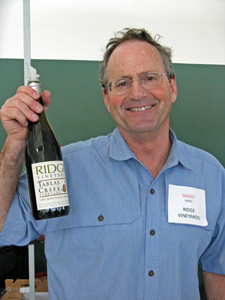 |
Ridge 2013 Grenache/Mataro, “Lytton Estate,” Lytton Estate, Dry Creek Valley. 40% Grenache, 40% Mataro, 15% Zinfandel, 5% Carignane. Medium color, this had bright aromas of black cherry and plum, spice, earth, and touches of dried herbs and pepper. Medium-bodied with a very lively texture, finishing with moderate tannins, nice.
Ridge 2013 Carignane, Buchignani Ranch, Sonoma County. A small-production bottling from 75-year old head-trained vines in the hills north of Dry Creek Valley. Medium-dark purple, with brambly red fruit, earth, and spice on the nose. Medium-full bodied, with fairly grippy tannins on the finish.
Ridge / Tablas Creek 2012 “Joint Venture Grenache,” California. 75% Grenache, 25% Syrah, from 50% each Ridge and Tablas Creek. Medium color, this displayed earthy and savory aromas along with bright black cherry fruit and lots of spice. Medium weight on the palate with a juicy texture and good structure, finishing with firm but refined tannins, nice.
Ridge 2012 Petite Sirah, Lytton Estate, Dry Creek Valley. Very dark purple, featuring bright and intense aromas of dark berry fruit, flowers, with notes of earth and sweet oak. Big, dense, and chewy, this will need time in the cellar. (Tasted at the morning “See How They Age” seminar)
Ridge 2002 Petite Sirah, Lytton Estate, Dry Creek Valley. Dark brick/purple color, this showed more earthy and gamey character than the 2012 bottling, with plummy fruit and spice. Still big and bold, but with more refined tannins on the finish – this should be able to age for many more years. (Tasted at the morning “See How They Age” seminar)
Comments: Ridge is one of California’s most renowned wineries, founded in 1959. Paul Draper joined Ridge in 1969 and continues to head their winemaking team. They’ve made wines from Dry Creek Valley since the mid-1960s, and purchased their Lytton Springs property there in 1991. John Olney has been in charge of winemaking at Lytton Springs since 1999. David Gates joined Ridge in 1989, and manages the estate vineyards – he was on hand to pour at the tasting. The 2013 “Lytton Estate” bottling is the inaugural vintage of this wine. David opened a special one-off Ridge / Tablas Creek bottling while I was at the table, and this was one of the standout wines of the day.
Sierra Vista Winery
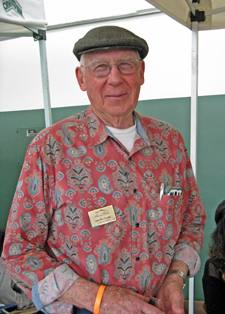 |
Sierra Vista 2014 Grenache Rosé, El Dorado County. Made in stainless steel. Very light salmon/straw color, this was not fruit-forward, showing spice and a lightly nutty note plus subtle red fruit aromas. Medium-light weight with a smoother texture and slight touch of tannin on the finish. (Tasted at the morning Rosé seminar)
Sierra Vista 2013 Grenache, Rayas Vineyard, Estate, El Dorado County. Medium ruby/garnet color, with bright red fruits, fresh herbs, earth, and notes of flowers and wet stone. Medium-bodied with a lively mouthfeel and firm but refined tannins, nice.
Sierra Vista 2012 Mourvèdre, “West Slope,” Estate, El Dorado County. Medium-dark purple, this displayed earth, black cherry, and spice on the nose. Medium weight with a fairly rich texture and moderate tannins.
Sierra Vista 2010 Syrah, “Red Rock Ridge,” Estate, El Dorado County. Darker color, featuring smoky and spicy aromas along with dark berry fruit, earth, and sweet oak. Medium-full bodied and structured, finishing with firm tannins.
Tiger Lily 2010 “Outlaw,” El Dorado County. Blend of about 50% Syrah along with Grenache and Mourvèdre. Medium color, with black cherry fruit, spice, and a stony mineral note. Medium-bodied with a fairly lively mouthfeel and chalky tannins on the finish.
Comments: Winemaker John MacCready and his wife Barbara bought their El Dorado County property in 1972 and the first vintage of Sierra Vista wines was in 1977. John planted Syrah in their estate vineyard in 1979, one of the earlier modern plantings of that variety in California. The Grenache vines from the estate Rayas Vineyard are believed to have originated from Château Rayas in Châteauneuf-du-Pape – some of this Grenache was grafted onto Cabernet in 2002 and some was planted on its own roots. The Tiger Lily label honors a winery that operated from the mid- to late-1800s in the same area as Sierra Vista. John was on hand at the tasting to pour his wines.
Silver Wines
El Ojo Blanco 2010 “Cuvée Uno,” Santa Barbara County. 100% Viognier, sourced from White Hawk and Vogelzang vineyards, made in 95% stainless steel and 5% oak. Medium-light straw color, displaying stone fruit and herb aromas along with a touch of spice. Medium-bodied with a fairly smooth mouthfeel and finish.
Silver 2009 Grenache Blanc, Santa Barbara County. 93% Grenache Blanc, 7% Viognier, sourced from Camp 4 Vineyard, made in older French oak. Very light straw color, this featured pear and stone fruit plus notes of petrol and spice on the nose. Medium weight on the palate with a lively texture and clean finish.
Silver 2010 Syrah, “Trentotto File,” White Hawk Vineyard, Santa Barbara County. 91% Syrah, 4% Mourvèdre, 3% Grenache, 2% Viognier, aged in 40% new oak. Dark purple color, with ripe dark berry fruit, lots of spice, earth and leather, plus undertones of sweet oak. Medium-full bodied with moderately grippy tannins on the finish. (Tasted at the morning “See How They Age” seminar)
Silver 2003 Syrah, “Trentotto File,” White Hawk Vineyard, Santa Barbara County. Aged in 35% new oak. Dark brick/purple, this showed more subtle plummy fruit than the 2010 bottling along with earth and spice components. Medium-full bodied and still showing lively acidity, finishing with chewy tannins. (Tasted at the morning “See How They Age” seminar)
Comments: Benjamin Silver launched his winery in 2000, after working his way up to become winemaker at Zaca Mesa Winery. Silver has been known over the years for its Viognier, and non-Rhône variety releases include Chardonnay, Pinot Noir, Nebbiolo, and couple of blends featuring Sangiovese, Cabernet Sauvignon, and Cab Franc. The “Trentotto File” fruit comes from a three-acre block of 38 vine rows, with 174 and 470 Syrah clones. Ben poured his wines at the tasting.
Skinner Vineyards
Skinner 2012 “Seven Generations,” El Dorado. 52% Grenache Blanc, 21% Roussanne, 17% Marsanne, 8% Viognier, 2% Picpoul, made in 20% stainless steel and 80% oak (10% new). Light straw color, this displayed ripe pear and stone fruit aromas along with hints of herbs and sweet oak. Medium-bodied with a long, smooth finish.
Skinner 2013 Rosé, El Dorado. From 55% Grenache and 45% Mourvèdre, grown and picked specifically for Rosé and made in neutral oak. Light salmon/pink color, with upfront red fruit along with spice and herb notes. Medium-light weight with a round but lively texture and crisp finish, nice.
Skinner 2012 Mourvèdre, Estate, El Dorado. Medium purple, this had a savory aromatic profile with herbs, smoke and meat, plus plummy fruit and earth in support. Medium-bodied with fine structure and moderate tannins – nice now and should age well too.
Skinner 2012 “Eighteen Sixty-One,” El Dorado. Grenache-based blend. Medium color, showing plum and blueberry fruit, herbs, with undertones of spice and vanilla/oak. Medium weight on the palate with good acidity and fairly firm tannins.
Comments: Mike and Carey Skinner established their family winery in the Fair Play area of El Dorado County in 2007, and Mike’s great-great-great grandfather James Skinner had planted vines and run a winery in the same region as far back as the 1860s. Skinner has quickly become one of El Dorado’s most consistent Rhône-style wine producers. They farm two estate vineyards – one at a lower elevation and one at a higher site next to the winery – and source most of their fruit from them. Winemaker Chris Pittenger and his wife Sarah were behind the winery table at the event, and they poured some fine wines.
Skylark Wine Company
 |
Skylark 2014 “Pink Belly,” Mendocino County. Made from 100% Grenache grapes farmed for Rosé and whole-cluster pressed into stainless steel. Light salmon/pink color, featuring bright aromas of fresh strawberries, herbs, and a slight floral note. Lighter-bodied and lively on the palate, with a slight tannic bite on the finish, nice.
Skylark 2014 Pinot Blanc, Orsi Vineyard, Mendocino County. From vines planted in 1975, whole-cluster pressed into stainless steel, with no malolactic fermentation. Light straw color, with pear and herb notes and a touch of spice. Medium-light bodied with a bright mouthfeel and finish.
Skylark 2012 “Las Aves,” North Coast. 33% Syrah, 25% Cabernet Sauvignon, 21% Carignane, 21% Grenache. Medium-dark color, this showed herbs and earth along with plum and currant fruit on the nose, with hints of spice and sweet oak in the background. Medium-bodied with a lively texture, finishing with firm tannins – still needs time but shows good promise.
Skylark 2009 Syrah, Rodgers Creek Vineyard, Sonoma Coast. From a “suitcase” Côte-Rôtie clone, about 33% whole-cluster fermentation and 30% new French oak. Medium-dark purple, with savory aromas of herbs and game upfront, along with dark fruits, smoke, and hints of flowers and pepper. Medium-bodied with great structure and firm but refined tannins – very nice now and with the potential to improve further with more time in the cellar.
Comments: Skylark was founded in 2002 by John Lancaster and Robert Perkins of Boulevard Restaurant in San Francisco. Most of the vineyard sources for the Skylark wines are from Sonoma and Mendocino counties. John poured at this tasting, and as usual, he presented a strong group of wines. The “Las Aves” blend is inspired by the wines of Priorat. I’ve been a fan of their Rodgers Creek Syrah, and the 2009 was another standout.
Tablas Creek Vineyard
Tablas Creek 2013 Grenache Blanc, Estate, Paso Robles. 100% Grenache Blanc, made in both stainless steel and oak. Very light straw color, this displayed apple and pear fruit, herbs, and a hint of lemonpeel. Medium-bodied with a bright mouthfeel and a clean finish, nice.
Tablas Creek 2012 “Esprit de Tablas Blanc,” Estate, Paso Robles. 75% Roussanne, 20% Grenache Blanc, 5% Picpoul Blanc, made in both stainless steel and oak. Light straw color, with riper pear and stone fruit aromas plus earth and a stony mineral note. Richer on the palate but retaining good acidity, with a long, smooth finish.
Tablas Creek 2012 “Esprit de Tablas,” Estate, Paso Robles. 40% Mourvédre, 30% Grenache, 21% Syrah, 9% Counoise, aged in 1200-gallon French oak foudres. Medium-dark purple, this displayed aromas of fresh plum, earth, dried herb, and flowers, with a touch of black pepper in the background. Medium-full bodied with a bright texture, good structure, and big but refined tannins, nice. (Tasted at the morning “See How They Age” seminar)
Tablas Creek 2003 “Esprit de Beaucastel,” Estate, Paso Robles. 50% Mourvèdre, 27% Grenache, 16% Syrah, 7% Counoise, aged in 1200-gallon French oak foudres. Medium brick/purple color, with a riper and darker fruit profile than the 2012, lots of spice, plus herb and earth notes. More full-bodied than the 2012 and still showing lively acidity and plenty of structure, finishing with chewy tannins – developing well and probably not yet at its peak. (Tasted at the morning “See How They Age” seminar)
Comments: Tablas Creek is co-owned by the Perrin family (of Château de Beaucastel fame) and Robert Haas (founder of Vineyard Brands importers). Their 120-acre estate vineyard on the Westside of Paso Robles was first planted in the early 1990s. The vineyard was certified organic in 2003 and has been farmed using more biodynamic techniques in recent years. I got to the winery table near the end of the tasting and only tried a couple of wines there. I also tasted a special one-off Ridge / Tablas Creek bottling while I was at the Ridge table, and this was one of the standout wines of the day – it’s listed with the Ridge wines.
Tercero Wines
Tercero 2014 Gewürztraminer, “The Outlier,” Santa Ynez Valley. 100% Gewürztraminer, from a vineyard in the Los Alamos area, made entirely in stainless steel, 0.6% residual sugar. Very light straw color, this had subtle lychee aromas along with notes of citrus and spice. Medium-light bodied with just a hint of sweetness on the finish.
Tercero 2013 Viognier, White Hawk Vineyard, Santa Barbara County. Light straw color, with tropical fruit and lightly floral scents. Medium weight on the palate with good acidity and a smooth finish.
Tercero 2014 Mourvèdre Rosé, Vogelzang Vineyard, Happy Canyon of Santa Barbara. 100% Mourvèdre, on the skins for about an hour, fermented in stainless steel and aged in neutral oak. Very light salmon/straw color, this displayed spice, plum, and earth aromas plus a savory component. Medium-light weight on the palate with bright acidity and a slightly chalky finish, nice. (Tasted at the morning Rosé seminar)
Tercero 2010 “The Climb,” Santa Barbara County. 67% Syrah from White Hawk and Larner vineyards, 33% Petite Sirah from Rodney’s Vineyard, aged in older oak. Medium purple color, featuring plum and darker fruits, lots of spice, earth, and a touch of dried herbs. Medium-bodied with a lively mouthfeel and moderate tannins.
Tercero 2010 Petite Sirah, Rodney’s Vineyard, Santa Barbara County. Dark color, this had a dark fruit profile along with pepper, spice, and herbs. Big and bold, with plenty of structure and firm but not harsh tannins on the finish.
Comments: Larry Schaffer started his Tercero label with the 2006 vintage while he was working for Fess Parker Winery – he’s focused on Tercero full-time since 2011. Larry uses stainless steel and neutral oak for fermenting and aging his white wines. With reds, he’s worked extensively with Grenache and increasingly with Mourvèdre, and he’s used more whole-cluster fermentations in recent years. I tasted many of the Tercero wines with Larry earlier in the year (Grenache Blanc, “Verbiage Blanc,” Watch Hill Vineyard Grenache, and Mourvèdre were favorites) so I picked just a few bottlings at this tasting.
Thirty-Seven Winery
Thirty-Seven 2013 Grenache, Sonoma Coast. Medium-light ruby color, this featured bright strawberry fruit, dried herbs, and touches of earth and spice. Medium-bodied with lively acidity and fine tannins on the finish, nice.
Thirty-Seven 2013 Syrah, Sonoma Coast. Medium-dark purple, with bright aromas of blackberry, herbs, and undertones of sweet oak. Moderately rich mouthfeel with good structure, finishing with bigger but refined tannins.
Comments: Proprietors Al Brayton and Elisa Correnti founded Thirty-Seven Winery in 2007 – they also run the Paradise View label. Their estate vineyard is near the intersection of highways 37 and 121 in the cool Petaluma Gap region, and the vines are from 8-12 years old. Both Al and Elisa were behind their winery table at the tasting, and Al told me that they are currently making Pinot Gris and Albariño in concrete eggs, and that they will have an upcoming Blaufränkisch. The wines are made at the Lynmar facility by Shane Finley.
Two Shepherds Vineyards
Two Shepherds 2012 Mourvèdre, Windsor Oaks Vineyard, Russian River Valley. 100% Mourvèdre, some whole-cluster fermentation, aged in neutral oak. Medium color, showing red fruit, spice, herbs, and a touch of black pepper on the nose. Medium-bodied with a lively texture and moderate tannins – a lighter rendition of Mourvèdre, nice.
Two Shepherds 2012 “Pastoral Rouge,” Russian River Valley. 45% Grenache, 25% Syrah, 30% Mourvèdre, sourced from Windsor Oaks and Saralee’s vineyards. Medium-light color, this had a bigger spice component along with earth, dried herbs, and plummy fruit. A bit bigger mouthfeel than the previous wine, with a firm tannic finish.
Two Shepherds 2013 Cinsault, Bechthold Vineyard, Lodi. From 120+ year old vines, fermented with whole clusters. Medium-light purple, with brambly berry fruit, earth, and spice on the nose. Medium weight and structured on the palate, finishing with fairly grippy tannins.
Comments: Two Shepherds is a Rhône specialist, producing both varietal wines and blends sourced from a number of California wine regions. The first commercial vintage was 2010. Owner/winemaker William Allen is well-known for his Simple Hedonisms wine blog. This was the last table I had time to visit at the event, and I was able to taste my fourth bottling of the day of Bechthold Vineyard Cinsault there. |


